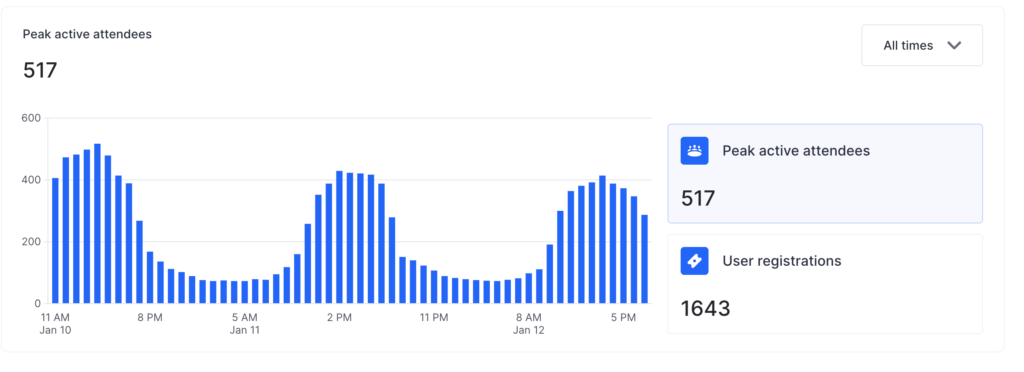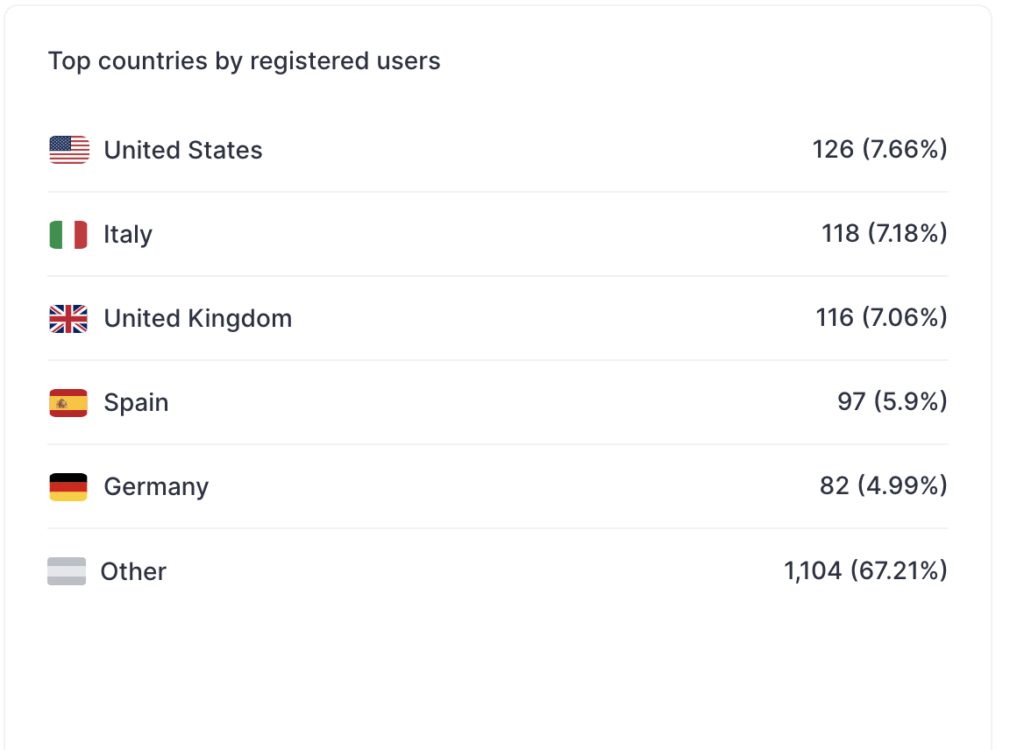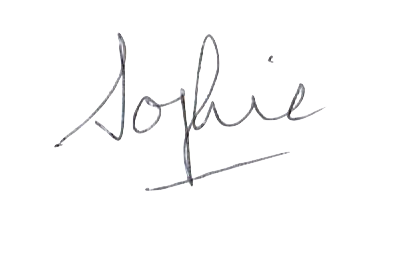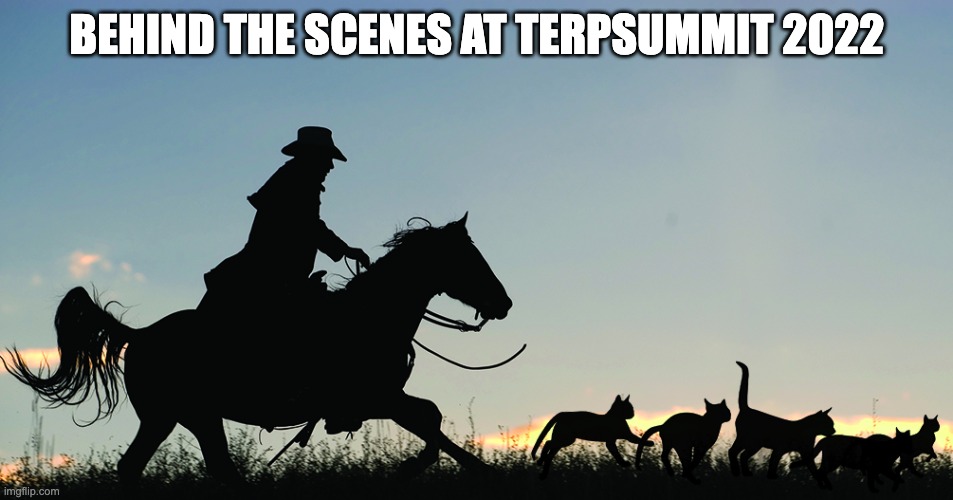Wondering what it took to organise an international online summit for interpreters, with interpretation into 9 languages?
Keen to know more about what it was like working with Green Terp?
Curious about what it was like to manage all those amazing speakers?

[hint: it was like herding cats…]
Read on…
TerpSummit 2022 in figures
- registrations: over 3,400 (this includes people who attended the live event, as well as those who registered in order to watch on replay).
- Hopin registrations: 1,643 (i.e. people who registered for the live event).
- Peak attendance: 517 – this stayed relatively steady across the 3 days, but may have been affected by the AIIC General Assembly and various other meetings taking place during the same week.
- Average time spent by attendees at the live event: 8 h 15 minutes (!).
- Number of speakers: more than 50, in fact. But that wasn’t entirely deliberate 😊. Some of the more last-minute additions to the programme wanted to have a panel-style discussion, which bumped up the speaker numbers.
- Number of urgent phone calls during the summit from speakers who had technical problems or couldn’t find or enter their Session: 3.
- Sponsors: 9, who contributed in kind with prizes for the draw; some of them also gave presentations about RSI platforms.
- Room hosts: 4. They helped introduce the speakers, run through the interpreting arrangements at the beginning of each session, and answer technical questions, so I owe a big thank you to Roxane Hugues, Camelia Oana, Silvana Vulcan, and Clara Campero. A truly international team based in the UK, Romania, and Argentina.
- Interpreters: 80 interpreters including standbys, dropouts and those who actually interpreted. Plus a 7 person tech team.
- Booths: 8 (French, German, Spanish, Italian, Portuguese, Mandarin, Arabic, Russian).
- Number of Zoom meetings with Laura Holcomb (interpreting coordinator): at least 7, of which one was a meeting with a tech guy from Hopin. I also attended 4 GreenTerp/Hopin rehearsals for the interpreters. And we talked on WhatsApp and emailed a lot!
Here are some insights from Hopin:


The tech
I kept this pretty simple.
- The live summit was hosted on Hopin. I chose this platform last year for the first TerpSummit because of its powerful networking features, as well as the ability to run parallel sessions, which I would not have been able to do on my Zoom account. Since then, Hopin has had very significant investment, and I found it more stable and a touch more user-friendly this time around.
- The two websites, hosting the TerpSummit pages (registration, schedule, ‘meet the speakers’, etc.) and the Interpreters’ Toolkit for Success (recordings, bonuses), are WordPress sites.
- I used Airtable extensively to keep track of what needed doing, collect material from speakers, gather feedback etc.
- I held quite a few meetings on Zoom to co-ordinate with the room hosts, Laura (the interpreting coordinator), or speakers.
- I used Vimeo to host and record videos, and Screencast-o-Matic for captioning.
- Once or twice I used Dropbox to transfer large files.
- I hosted some materials (slides, PDFs) on Google Drive.
- My CRM (i.e. the mailing system that communicates with people who’ve registered) is Drip.
- I used Acuity as a scheduling tool.
- How could I forget WhatsApp? I had 3 main lines of communication going: with Laura, with the interpreting Tech Support group (so I could keep an eye on potential issues), and with the Room Hosts – this was the busiest group, with quick-fire questions, technical help, words of encouragement, and the occasional venting about impatient attendees. Oh, and a few pet photos. 😉
As you can see, I didn’t go overboard with complicated tech (although I’ve spared you the details of the plugins I’ve used in WordPress, etc.).
The interpreting
When I decided to run a summit in 2021, there was a lot to think about: finding the right speakers, building the websites, working out how to charge (or not!), researching live event platforms, deciding what I could afford…There was no way I could add interpretation into the mix, even though it galled me, as an interpreter, to organise a monolingual event.
For TerpSummit 2022, I wanted to at least look into the possibility of offering interpretation. I did this for several reasons: accessibility for those who can’t follow some of the speakers in their mother tongue; trying to move away from a Eurocentric, anglocentric event; offering the whole interpreting community an opportunity to try out one of the remote interpreting tools; and just because I felt it was the right thing to do!
I was talking to Laura Holcomb on Zoom sometime in November about giving a talk on consecutive note-taking in healthcare settings, and we got on to the subject of offering interpretation at the summit. I feel very fortunate that she was enthusiastic about the idea; more, she offered to co-ordinate the interpreting arrangements.
We’ve had some time to think about the outcome since then, and overall I think we’re very happy that we went ahead with this very ambitious enterprise. Laura reached out to Dr Bernard Song from Green Terp because the idea of a system designed by interpreters for interpreters appealed to us, and I’m very grateful that Bernard came on board and worked incredibly hard (from a difficult time zone!) to make sure that the GT Booth system was ready for an event involving 9 languages (English, French, German, Spanish, Italian, Portuguese, Mandarin, Arabic, Russian) – the GT extension for Chrome and Firefox was released just before the Summit.
I’ve asked Laura and Bernard, as well as some of the volunteer interpreters, to share their experiences – both highs and lows, because there were definitely some lows! – with us. You will find their replies to my questions below.
Debrief with the interpreters
We held a public Zoom session to ask the interpreters what it was like using Green Terp.
Here are the questions we asked:
1. How long did it take you to prepare for TerpSummit? (Including familiarising yourself with the tool (GTB) and materials such as slides/videos). Anything particularly interesting or different that you noticed during the process?
2. Many of you have worked on other RSI platforms. What was different about working on GT Booth compared with other RSI platforms, in terms of functionalities, training, technical support or tool friendliness?
3. What are the potential improvements you would like to see interpreter team make-up and organisation, training, tech support or tool functionality?
4. What was a challenge you overcame successfully or your favourite part of the experience in general?
Working with Laura Holcomb and Dr Bernard Song
What made you want to participate in TerpSummit?
Bernard: I participated the first TerpSummit last year, and I thought it was a brilliant idea. We interpreters as a community tend to work in small groups and socialise within the region of our domicile, but never had such a chance to meet up on a global scale prior to the pandemic (that’s a blessing of this pandemic!). It is a brilliant opportunity when Laura mentioned to me that you two were considering adding interpretation to this summit, to get involved and contribute to such an occasion. As an interpreters’ event, why can’t we have it interpreted?
Laura: I had seen a bit of your work and respected you, and it, very much as a colleague. That’s a good starting point for wanting to be involved—admiration and attraction to a certain type of leadership. That was further bolstered by your willingness to put on a free summit. I loved the initiative and am always looking for meaningful ways to contribute that might expand my horizons at the same time. In this case specifically, I would be involved in cross-ocean work, would be given a chance to hop out of my silos, and would be working to steady interpreters with a new tech tool, a tool that was not only new to me, but also in the final stages of beta development.
Finally, I thought it odd that interpreting conferences didn’t actually have interpreting. Sometimes presenters would be speaking their third or fourth language. Some can manage this quite easily but I was not raised bilingually and so have accepted that I will probably forever be more dynamic as a presenter in my mother tongue. I imagined there were others in my shoes with something to say, as well as interpreters who might not have English in their combination.
Furthermore, at first blush, it actually didn’t seem like it would be a big deal. I have, by now, a solid base and a bit of a fondness for organizing interpreters and working with them in unfamiliar tech environments. So starting with “oh, this will be no big deal” gave me the courage to stretch. And stretch I did!
[Sophie: I think Laura and I both had moments when we thought we had bitten off more than we could chew…but I had gone with a ‘go big or go home’ idea, and I thought it was worth seeing it through, even if the result on the day wasn’t optimal. After all, this is the reality of working with RSI].
How did you go about planning what needed to be done?
Bernard: Together with Laura, we planned for the training/orientation of the interpreters, and I helped recruit and train part of the Chinese booths. Laura did most of the work in planning and organising the team really, and I tried to support with technical resources. It is definitely an overwhelming job to organise such a large team, with last min dropouts and signups, interpreters with different tech levels.
Laura: The steps in general are by now quite automated in my head: see who is interested (whatsapp groups, ask around), collect basic info from volunteers, as well as tech info (headset, connection, mac vs pc, etc.) and understand the volunteers’ motivations. This last bit helps me better tailor my communication and support (for all this I used a google form which is great for anything informal and the answers then feed to a google sheet that I can easily organize, sort and tinker with).
Then, the next step was to demo the platform to ease in gently (I used calendly to set up different time slots. This was a bit of a guessing game at first due to the different time zones and work demands of the varied group. I ended up having to do a few extra demos to accommodate latecomers or tight schedules).
I knew I wanted to follow this up with a full rehearsal to give myself, interpreters and techs a bit of actual hands-on practice as a group, and test relay, in particular. So I created a couple more rehearsal slots for this.
While time marched forward, a circular scheduling management process hummed along in the background (another google sheet). I had at least had a good primer on this with all the scheduling management I have done for co>lab and Lab7 Healthcare—two fairly complex peer practice based intensives, the latter involving 150 medical students coming in and out of the doors of a virtual meeting space.
From there, the booth schedule morphed into an interpreter dashboard where I organized essential links, posted the most up-to-date speaking schedule for each day and shared interpreter contact information. Without the dashboard, an easily updatable, centralized repository, I would have been lost.
We also created a WhatsApp support chat that I knew would be essential for off-platform, quick communication. Some of our China-based colleagues don’t have access to WhatsApp and depend on WeChat. But I couldn’t access WeChat from Guatemala so we had to have some intermediaries!
Alongside this was the task of organizing the tech work. I called in some friends and colleagues and tried to do some organizing, but this part was tough—all busy, in-demand professionals. But it all worked out because this group was very happy to and capable of practicing on their own.
Those were the basic nuts and bolts.
[Sophie: the dashboard was a fantastic tool, which kept all the relevant information in one place, so the interpreters could see the booth schedule, important links (Hopin, speaker bios), and materials (slides, PDFs) very easily, and everyone else (techs, Laura, Bernard, and me) had contact information to hand.]
What did it take to pull this off?
Bernard: Regarding the GT technical side, we did two major upgrades on the interpreter end (Auto-Relay) and audience end (GreenTerp Extension) under time pressure. We had a server issue identified in the first formal rehearsal and quickly resolved that. So in the end, we had a stable server running that is able to support up to 10k audience and 10 booths.
I under-estimated the time commitment, to be honest, but I never regretted it. If you ask me to choose again, I would say yes for sure. I didn’t use any time trackers, but I did work late every day to make sure that GT Booth is as smooth and easy to an interpreter, as an iPhone to a consumer. Working at odd hours is unavoidable when we need to train and collaborate with colleagues from different time zones, but it was an unforgettable and worthwhile experience.
Laura: This work was pretty much my full time job beginning Dec 6th and running through the Summit. I was able to work in some other professional commitments as needed, and decently able to take two weeks off at Christmas while traveling to see family, which was wonderful and quite important, but the bulk of my time went to getting everything and everyone situated, as best I could.
[Sophie: I reached out to a few speakers in July 2021, and started planning in earnest in September. From mid-November onwards, the Summit takes up all my available ‘spare’ (ha!) time and more. It displaces some other professional activities such as coaching or working on e-courses, runs on into the evenings, and continues for around 4 weeks after the summit. What seems like 3 intensive days to outsiders is actually nearly 3 months of work for me.]
Biggest challenge?
Bernard: The server failure in the first rehearsal, but that was a good stress test, so we were fully prepared afterwards. There were other challenges behind the scenes, with our superb technicians team (Laura, Ernest, Tamber, Amy, Yang), we pulled it off.
Laura:
Time zones are a challenge, such a concrete challenge, so not much to be done. You overcome it with teamwork and compromise. For demos and rehearsals, I tried to offer varied slots that would have a good chance of being accessible in at least two time zones per slot. Mic checks had to happen an hour before start time which meant a very early wake-up for me here in Guatemala. This challenge was overcome by asking for some extra help from my awesome partner Byron to take over the family duties. Plus, others such as Ernest and Dr. Bernard were making the same effort, so it was nice not to be alone on that front. In the future, this could be better overcome by getting tech coverage in a more amenable time zone. Even then, it is what it is. I would want to be there come start time in any case.
Working with a developing platform and different levels of tech comfort. An inclusive environment was important to me on the tech front. Because I work with so many interpreters on this, I know tech can be a challenge, but I also know we are all capable of learning—and learning was one of the points of picking a newer platform. We overcame this by titrating out the intro to the platform: watch and absorb the videos, let’s demo now and just walk through it, okay, now on to the rehearsal. Normally any tech barriers can be overcome by just spending some extra one-on-one time with folks, but here the problem was that I truly didn’t have that time. However, by and large, the interpreters who signed up for this charge were steady on their feet and tech amenable. And I was grateful for that. In the future it might be useful to make it clearer to myself that this is not the environment best suited for learning or even practicing basic tech skills in themselves (a good tech course would be a much better set-up for success!), but see it more as a good chance for those who already have solid tech footing to expand their reach.
Turnover. We had dropouts for a variety of reasons; people we had been investing in since December. This was overcome by a bit of sweat equity, teamwork and some agile folks stepping in at the last minute. Some interpreters pitched in with extra shifts to reduce the number of last minute GT trainings we would have to do. Ernest went above and beyond to help me do some of the last minute fly-by-the seat intros to GT for new interpreters filling in. For next time I am thinking this might have been better mitigated by staffing three-person booths from the outset, instead of the two-person booth that I am more accustomed to.
What did you get out of the experience?
Bernard: Laura and Sophie, you two had faith in me and in Green Terp with our new product, and supported this ambitious plan to take shape step by step. I also learned a lot from you guys on organising such a large event, with so many interpreters, and the amazing technicians team that is comprised of interpreters too! These are the most valuable part of the experience involving in this event. I really believe in the mantra that the more you give, the more you will get.
Laura:
I was privileged to work with a whole bunch of really kind, highly competent colleagues. Many of which I did not know ahead of this experience.
I learned more tech skills, because this is inevitable when working with a new tool and a new set of people.
And, I will be honest, I am a, let’s say, small deal, and do not typically manage 8-language events, over multiple days, with this many interpreters. So being part of something of this scope will certainly make me more efficient and better prepared the next time around, for large and small events alike.
And quite importantly, I learned what it’s like to put your everything into something and still not quite know if it will turn out okay at all. To really not know. And to give that up to the world of things that are out of my hands.
I got to be a part of some pretty selfless giving on all fronts – a free summit (incredible!) organized by Sophie entirely on her own “time dime”, plus a volunteer platform, techs, interpreters and speakers. A lot of people coming together to share. Just because. That’s special.
[Sophie: I can relate relate to Laura’s point about putting your all into something and not knowing if it will work. Hosting a live event like this is seat-of-your-pants stuff: it’s really exciting, the energy is phenomenal; but it could go horribly wrong at any time…Definitely not my natural comfort zone! But as Chris Guichot de Fortis would say, if you want to walk on water, get out of the boat!]

Attendees’ impressions
I sent out a feedback form after the Summit to ask attendees about various things: their favourite presentations, suggested topics, etc.
One of the points I was most interested in was attendees’ views on the interpreting arrangements: was it worth doing? Did they actually use interpretation?
I won’t give you a detailed breakdown of the replies. Instead, I’ll summarise.
Around half of respondents found GT Booth convenient, with only minor issues (the most problematic part was when we had multilingual sessions with relay. The audio quality suffered in booths working on relay.)
Around half of respondents didn’t need or didn’t use interpretation.
However, the interesting thing, as far as I’m concerned, is that over 3/4 of respondents felt that offering interpretation at the summit was worthwhile (even if they didn’t use it!).
The reasons are neatly summed up in this response:
“Yes, it’s worth it to expand the range of speakers, to avoid a Western-centric view of the world, to offer practice opportunities and makes us be users of interpretation for once, which can be very enlightening.”
Will there be a next time?
Well….
When the live event is taking place, TerpSummit is very exciting! It’s fantastic for me to see interpreters learning from one another, coming together from all around the globe, being supportive, having an opportunity to make new contacts.
I can’t say enough how grateful I am to everyone who made the summit what it was: Bernard and Laura, the techs, Room Hosts, interpreters, speakers…and the audience!
As you will hopefully have realised from this blog post, it’s also a big task in terms of organisation.
This year, I again have to digest the outcome and decide if running the event is worthwhile for me, personally, professionally, and financially.
Some of the issues for me to consider are:
- am I confident that I can gather the best speakers, who have a really useful contribution to make on relevant topics?
- am I satisfied with the pricing model – does it cover my costs (a live event platform like Hopin costs in the thousands of euros, just sayin’); is it too much work offering the Interpreters’ Toolkit with all the bonuses? This is something I’ve explored through the feedback form, and the responses haven’t necessarily matched my expectations!
- would I offer interpretation again (for some sessions? All sessions?)
There are many more, which I will spare you. Thank you for reading, and do comment below!

p.s. for anyone who’s disappointed that the title ‘BTS TerpSummit and GreenTerp’ on the video above didn’t actually mean that BTS were involved in any way 😉, here they are being smooth like butter:

